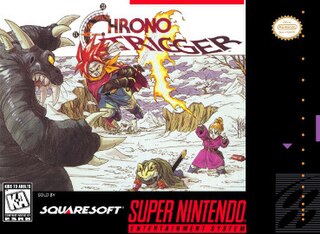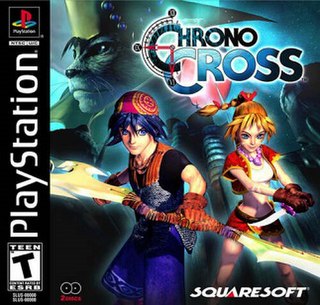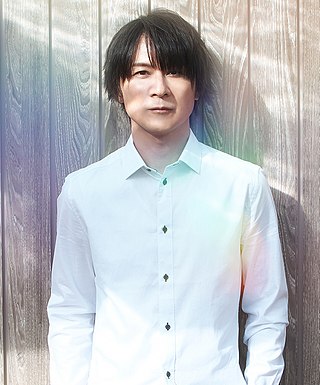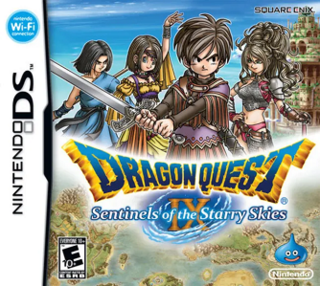
Chrono Trigger is a 1995 role-playing video game developed and published by Square. It was originally released for the Super Nintendo Entertainment System as the first entry in the Chrono series. The game's development team included three designers that Square dubbed the "Dream Team": Hironobu Sakaguchi, creator of Square's Final Fantasy series; Yuji Horii, creator of Enix's Dragon Quest series; and Akira Toriyama, character designer of Dragon Quest and author of the Dragon Ball manga series. In addition, Takashi Tokita co-directed the game and co-wrote the scenario, Kazuhiko Aoki produced the game, while Masato Kato wrote most of the story. The game's plot follows a group of adventurers who travel through time to prevent a global catastrophe.

Chrono Cross is a 1999 role-playing video game developed and published by Square for the PlayStation video game console. It is set in the same world as Chrono Trigger, which was released in 1995 for the Super Nintendo Entertainment System. Chrono Cross was designed primarily by scenarist and director Masato Kato, who had help from other designers who also worked on Chrono Trigger, including art director Yasuyuki Honne and composer Yasunori Mitsuda. Nobuteru Yūki designed the characters of the game.

Radical Dreamers is a 1996 text-based visual novel adventure video game developed and published by Square for the Satellaview, a satellite peripheral for the Super Famicom. It forms part of the Chrono series, acting as a side story to the 1995 game Chrono Trigger. A version of the game is included with Chrono Cross: The Radical Dreamers Edition, which was released worldwide on April 7, 2022 for Windows, the Nintendo Switch, the PlayStation 4 and the Xbox One.

Final Fantasy IV, titled Final Fantasy II in its initial North American release, is a role-playing video game developed and published by Square for the Super Nintendo Entertainment System. Released in 1991, it is the fourth main installment of the Final Fantasy series. The game's story follows Cecil, a dark knight, as he tries to prevent the sorcerer Golbez from seizing powerful crystals and destroying the world. He is joined on this quest by a frequently changing group of allies. Final Fantasy IV introduced innovations that became staples of the Final Fantasy series and role-playing games in general. Its "Active Time Battle" system was used in five subsequent Final Fantasy games, and unlike prior games in the series, IV gave each character their own unchangeable character class — although at a few points in the story, a dark knight will choose the path of a paladin, or a summoner will evolve to a new tier of spellcasting.

Final Fantasy VII is a 1997 role-playing video game developed by Square for the PlayStation console and the seventh main installment in the Final Fantasy series. Square published the game in Japan, and it was released in other regions by Sony Computer Entertainment, becoming the first game in the main series to have a PAL release. The game's story follows Cloud Strife, a mercenary who joins an eco-terrorist organization to stop a world-controlling megacorporation from using the planet's life essence as an energy source. Events send Cloud and his allies in pursuit of Sephiroth, a superhuman who seeks to wound the planet and harness its healing power to be reborn as a god. During their journey, Cloud bonds with his party members, including Aerith Gainsborough, who holds the secret to saving their world.

Final Fantasy Chronicles is a compilation of Square's role-playing video games Final Fantasy IV (1991) and Chrono Trigger (1995), released for the North American Sony PlayStation on July 2, 2001. TOSE ported both titles from the Super Nintendo Entertainment System; each had been previously released as individual Japanese PlayStation ports in 1997 and 1999. Several bonus features were added to each game, such as art galleries, bestiaries, and cutscenes—including computer-generated imagery full motion video used at the beginning of Final Fantasy IV and anime scenes used throughout Chrono Trigger.

Secret of Mana, originally released in Japan as Seiken Densetsu 2, is a 1993 action role-playing game developed and published by Square for the Super Nintendo Entertainment System. It is the sequel to the 1991 game Seiken Densetsu, released in North America as Final Fantasy Adventure and in Europe as Mystic Quest, and it was the first Seiken Densetsu title to be marketed as part of the Mana series rather than the Final Fantasy series. Set in a high fantasy universe, the game follows three heroes as they attempt to prevent an empire from conquering the world with the power of an ancient flying fortress.
Chrono Break is a cancelled third mainline entry in the Chrono series of video games by Square. While never officially announced by the company, commentary from Chrono series developers Masato Kato, Hironobu Sakaguchi, and Takashi Tokita have confirmed early plans for the game, alongside a number of trademarks filed in the game's name. However, the game would ultimately go unproduced, with many members of the internal development team either moving on to Final Fantasy XI or leaving the company in favor of freelance work. The game elicited much commentary from the company and the video game press in the following years, though as of 2021, all trademarks had expired, with no announced plans to work on the game.
Masato Kato is a Japanese video game artist, scenario writer and director. In the early days of his career, he was credited under the pseudonyms of "Runmaru" and "Runmal". He then joined Square, and was most famous for penning the script of Chrono Trigger, as well as Radical Dreamers, Xenogears, Chrono Cross, Final Fantasy XI and parts of Final Fantasy VII.

Trials of Mana, also known by its Japanese title Seiken Densetsu 3, is a 1995 action role-playing game developed and published by Square for the Super Famicom. It is the sequel to the 1993 game Secret of Mana, and is the third installment in the Mana series. Set in a high fantasy world, the game follows three heroes as they attempt to claim the legendary Mana Sword and prevent the Benevodons from being unleashed and destroying the world. It features three main plotlines and six different possible main characters, each with their own storylines, and allows two players to play simultaneously. Trials of Mana builds on the gameplay of its predecessor with multiple enhancements, including the use of a time progression system with transitions from day to night and weekday to weekday in game time, and a wide range of character classes to choose from, which provides each character with an exclusive set of skills and status progression.

The Chrono series is a video game franchise developed and published by Square Enix. It began in 1995 with the time travel role-playing video game Chrono Trigger, which spawned two continuations, Radical Dreamers and Chrono Cross. The music of Chrono Trigger was mainly composed by Yasunori Mitsuda, with a few tracks composed by regular Final Fantasy composer Nobuo Uematsu. The Chrono Trigger soundtrack has inspired four official album releases by Square Enix: a soundtrack album released by NTT Publishing in 1995 and re-released in 2004, a greatest hits album published by DigiCube in 1999, published in abbreviated form by Tokyopop in 2001, and republished by Square Enix in 2005, an acid jazz arrangement album published and republished by NTT Publishing in 1995 and 2004, and a 2008 orchestral arranged album by Square Enix. Corresponding with the Nintendo DS release of the game, a reissued soundtrack was released in 2009. An arranged album for Chrono Trigger and Chrono Cross, entitled To Far Away Times, was released in 2015 to commemorate the 20 year anniversary of Chrono Trigger.
The Chrono series is a video game franchise developed and published by Square, and is currently owned by Square Enix. The series began in 1995 with the time travel role-playing video game Chrono Trigger, which spawned two continuations, Radical Dreamers: Nusumenai Hōseki, and Chrono Cross. A promotional anime called Dimensional Adventure Numa Monjar and two ports of Chrono Trigger were also produced. As of March 31, 2003, Chrono Trigger was Square Enix's 12th best-selling game, with 2.65 million units shipped. Chrono Cross was the 24th, with 1.5 million units shipped. By 2019, the two games had sold over 5.5 million units combined. The games in the series have been called some of the greatest of all time, with most of the praise going towards Chrono Trigger. The series' original soundtracks, composed by Yasunori Mitsuda, have also been praised, with multiple soundtracks being released for them.

Dragon Quest IX: Sentinels of the Starry Skies is a role-playing video game co-developed by Level-5 and Square Enix for the Nintendo DS. Published by Square Enix in Japan in 2009, and by Nintendo overseas in 2010, it is the ninth mainline entry in the Dragon Quest series. The storyline follows the protagonist, a member of the angelic Celestrian race, after a disaster in their home scatters magical fruits across the mortal realm. While carrying over traditional gameplay from the rest of the series with turn-based battles, the game is the first Dragon Quest entry to feature a customizable player character, and the first to include a multiplayer mode, with the option of trading treasure maps and loaning player characters through Nintendo Wi-Fi. Online functions ended in 2014 when it ceased operations.
Takashi Tokita is a Japanese video game developer working for Square Enix. He has worked there since 1985, and has worked as the lead designer for Final Fantasy IV as well as the director of Live A Live, Parasite Eve and Chrono Trigger.

Kingdom Hearts 358/2 Days is an action role-playing video game developed by h.a.n.d. and Square Enix in collaboration with Disney Interactive Studios for the Nintendo DS. It is the fifth installment in the Kingdom Hearts series, and takes place near the end of the first game in parallel to Kingdom Hearts: Chain of Memories, leading directly into the events of Kingdom Hearts II. The game was released worldwide in 2009. The story is told from the perspective of Roxas, and follows his daily life within Organization XIII and his relationship with fellow Organization member Axel; it also introduces a fourteenth member, Xion, who befriends them.

Kingdom Hearts Coded is an episodic action role-playing puzzle video game developed and published by Square Enix, in collaboration with Disney Interactive Studios, for mobile phones. Coded was a Japan-only release announced at the 2007 Tokyo Game Show. Its Nintendo DS remake titled Kingdom Hearts Re:coded was released in Japan, North America, Europe, and Australia. A cinematic remake of the game was included in the Kingdom Hearts HD 2.5 Remix video game compilation for the PlayStation 3, PlayStation 4, Xbox One, Windows, and Nintendo Switch.
A fan game is a video game that is created by fans of a certain topic or IP. They are usually based on one, or in some cases several, video game entries or franchises. Many fan games attempt to clone or remake the original game's design, gameplay, and characters, but it is equally common for fans to develop a unique game using another as a template. Though the quality of fan games has always varied, recent advances in computer technology and in available tools, e.g. through open source software, have made creating high-quality games easier. Fan games can be seen as user-generated content, as part of the retrogaming phenomena, and as expression of the remix culture.

Yuji Horii is a Japanese author, video game designer, writer and director best known as the creator of the Dragon Quest franchise, supervising and writing the scenario for Chrono Trigger, and The Portopia Serial Murder Case, released in 1983 as one of the first visual novel adventure games.
Chrono Trigger: Crimson Echoes is a fangame developed by the international team Kajar Laboratories as a ROM hack of Square's role-playing video game Chrono Trigger for the Super Nintendo Entertainment System. It was conceived as an unofficial installment in the Chrono series, set between the events of Chrono Trigger and its sequel Chrono Cross.

Final Fantasy III is a Nintendo DS role-playing video game and a remake of the 1990 Family Computer game, Final Fantasy III.
















